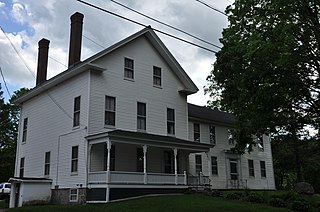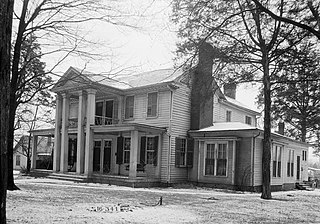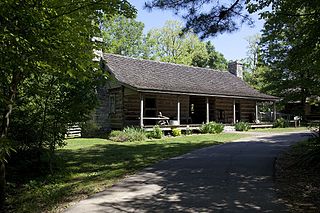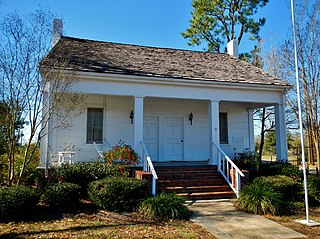
The Sloan–Parker House, also known as the Stone House, Parker Family Residence, or Richard Sloan House, is a late-18th-century stone residence near Junction, Hampshire County, in the U.S. state of West Virginia. It was built on land vacated by the Shawnee after the Native American nation had been violently forced to move west to Kansas following their defeat at the Battle of Point Pleasant in 1774. The building was added to the National Register of Historic Places on June 5, 1975, becoming Hampshire County's first property to be listed on the register. The Sloan–Parker House has been in the Parker family since 1854. The house and its adjacent farm are located along the Northwestern Turnpike in the rural Mill Creek valley.

Abraham Lincoln Birthplace National Historical Park is a designated U.S. historic park preserving two separate farm sites in LaRue County, Kentucky, where Abraham Lincoln was born and lived early in his childhood. He was born at the Sinking Spring site south of Hodgenville and remained there until the family moved to the Knob Creek Farm northeast of Hodgenville when he was two years old, living there until he was seven years of age. The park's visitor center is located at the Sinking Spring site.

The Magnolia Mound Plantation House is a French Creole house constructed in 1791 near the Mississippi River in Baton Rouge, Louisiana. Many period documents refer to the plantation as Mount Magnolia. The house and several original outbuildings on the grounds of Magnolia Mound Plantation are examples of the vernacular architectural influences of early settlers from France and the West Indies. The complex is owned by the city of Baton Rouge and maintained by its Recreation Commission (BREC). It is located approximately one mile south of downtown.

The Daniel Webster Family Home, also known as The Elms, is a historic house off South Main Street in West Franklin, New Hampshire. The house has been designated a National Historic Landmark for its importance as the summer home of Daniel Webster (1782–1852), who owned it from 1829 until his death.

Benjamin Church House is a Colonial Revival house at 1014 Hope Street in Bristol, Rhode Island, U.S.A. It opened in 1909 as the "Benjamin Church Home for Aged Men" as stipulated by Benjamin Church's will. Beginning in 1934, during the Great Depression, it admitted women. The house was closed in 1968 and became a National Register of Historic Places listing in 1971. The non-profit Benjamin Church Senior Center was incorporated in June 1972 and opened on September 1, 1972. It continues to operate as a senior center.

The Embassy of Uzbekistan in Washington, D.C.,, is the diplomatic mission of the Republic of Uzbekistan to the United States. The current Ambassador of Uzbekistan to the United States is Furqat Sidikov. The embassy is located at 1746 Massachusetts Avenue NW on Embassy Row in Washington, D.C., between Scott Circle and Dupont Circle. Constructed in 1909, the Clarence Moore House is an example of Beaux Arts architecture in blond Roman brick with limestone dressings; it was used by the Canadian government until the 1980s. The house was listed on the National Register of Historic Places (NRHP) on April 3, 1973. The building is also designated a contributing property to the Massachusetts Avenue Historic District and Dupont Circle Historic District, which are both listed on the NRHP.

Travellers Rest, also known as Golgotha, is a former plantation and historic plantation house, located in Nashville, Tennessee. The first owner of the site was John Overton in 1796, who built the first family home in 1799. For many years this plantation was worked and maintained by enslaved Black people.

The Houston Memorial Library, previously the Governor George Smith Houston House, is a historic residence in Athens, Alabama. It was built in Federal style in 1835. The house was listed on the National Register of Historic Places in 1986.
The Oates House is a historic home in Abbeville, Alabama. The house was listed on the National Register of Historic Places in 1989.

The Avondale Mill Historic District is a former mill village in Pell City, Alabama. Part of the Avondale Mills, the area is architecturally significant for the first sawtooth roofed mill in Alabama, and the mill village represents a relatively intact example of an early 20th century company town. The mill and its village were listed on the National Register of Historic Places in 2000. The mill closed in 2006, and burned in 2008 while being dismantled for scrap.

The McCrary House is a historic farm house near Huntsville in Madison County, Alabama. Founded after the initial federal land sale in Madison County in 1809, the farm has been in the McCrary family throughout. It was recognized as an Alabama Century & Heritage Farm in 1979, and reaffirmed on its 200th anniversary in 2009. Additionally, the house was listed on the Alabama Register of Landmarks and Heritage in 1979 and the National Register of Historic Places in 1982.

Burritt on the Mountain is an open-air museum in Huntsville, Alabama. The museum grounds on Round Top Mountain, a plateau connected to Monte Sano Mountain, were the estate of local physician William Burritt, who willed his house and land to the city for use as a museum upon his death in 1955. A number of 19th-century rural structures have been added to Burritt's mansion, both in the interest of historical preservation and life re-enactment.

Oak Place is a historic residence in Huntsville, Alabama. It was built by renowned Huntsville architect George Steele in 1840 on 320 acres. Steele designed a number of buildings across the South, including the First National Bank building in Huntsville, and the second Madison County Courthouse, which stood from 1840 until 1914. Similar to many of his buildings, Steele designed the Oak Place house in a Greek Revival style, although much more restrained in detail.

Greenlawn is a historic residence between Meridianville and Huntsville, Alabama. The house was built in 1849–50 by William Otey, replacing a log house built by his father in the early 1810s. Following William and his wife's deaths, the house was taken over by one of their granddaughters in 1907. Around 1925, the original Italianate portico was replaced with the current Greek Revival entrance, and a northern wing was added. The house fell vacant in 1963 and was later restored, now sitting at the entrance to a subdivision of the same name.

The Jude–Crutcher House is a historic plantation house in Huntsville, Alabama. The house was built circa 1812 on land deeded that year to Samuel Echols. Echols sold 54 acres and the house to George Jude, Sr., in 1817. Jude died two years later, leaving the land to his son, George Jr. The younger Jude eventually acquired 800 acres and owned 31 slaves. Upon his death in 1873, the land stayed in the family until 1883. In 1906 David Crutcher, who had been born a slave on an adjacent plantation in 1851, purchased the house and 154 acres along with two other African-American men. The Crutchers operated a successful farm on their portion of the land, which was an extension farm for Alabama A&M University until the 1940s. Only 7% of African-American farmers in Madison County in 1910 owned their own farms. David died in 1924, and his wife, Lucy, died in 1943, although the house and land is still in the family.

The William Lanford House is a historic residence in Huntsville, Alabama. The house was built by William Lanford, a native of Spotsylvania County, Virginia. Lanford's father, Robert, was an early land speculator who came to Huntsville from Nashville along with LeRoy Pope. William purchased 1,975 acres in 1843 and built his house in 1850. Lanford's daughter, Mary, married physician John R. Slaughter in 1853, who later moved his practice to the house in William Lanford's later life. Upon his death in 1881, the land was divided among Lanford's daughters, with Mary and Dr. Slaughter remaining in the house. After Mary's death in 1913, the house was sold to William Olin Camper in 1919. Camper and his brother Robert were merchants in Madison and Huntsville, and owned the Twickenham Hotel in Huntsville.

The Boxwood Plantation Slave Quarter is a historic building near Trinity, in Lawrence County, Alabama. The plantation was founded in late 1810s by Samuel Elliot, an Ulsterman who had originally settled in Middle Tennessee. Elliott and his son, Samuel Jr., built Boxwood into one of the largest plantations in the county, with $36,000 in real property and 92 slaves by 1860. Both the main plantation house and the slave quarters were built in the mid-1850s. Although the main house was demolished in the 1950s to make way for the widening of Highway 20, the slave quarter was remodeled and continued to serve as a house. The surrounding area continued to operate as a farm until 2010, when the land was purchased to construct an industrial park. The quarter is being preserved, and the later alterations have been removed, revealing the building's original form.
Harrington-Dewar House is a historic house located near Duncan, NC, Harnett County, North Carolina. The main house dates to 1865, and is a two-story frame I-house with vernacular Greek Revival style design elements. At the rear is an older two-room house built in about 1850 and consists of a 1+1⁄2-story gabled kitchen and dining room wing. Originally the back ell rooms were entered via the front porch at the time, which became the side porch when the 2 story house was added in 1865. The house was moved to its original location in 1977 when it was cited to be burned down by the owners. It was purchased and moved 5 miles within the Cokesbury Community near the village of Duncan, NC.

The James Martin House is a historic residence in Florence, Alabama. Martin was a leading Florence industrialist of the Antebellum era, who owned a cotton spinning mill along Cypress Creek. He had come to Florence from Jefferson County, Kentucky, and established his mill in 1839. A fire destroyed the complex in 1844, but was rebuilt and reopened in 1850. The mill was destroyed during the Civil War, but not rebuilt before Martin's death in 1869. Martin's sons operated the mill until 1873, and owned the house until 1879. It was purchased in 1886 by John Bounds, and remained in his family until 1974.

The Kennedy House is a historic residence in Abbeville, Alabama. The house was listed on the Alabama Register of Landmarks and Heritage in 1976 and the National Register of Historic Places in 1978.






















